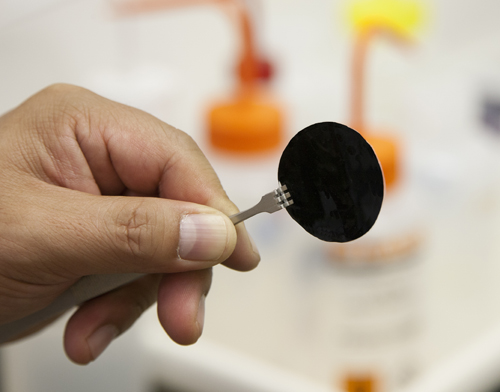A ‘second skin’ military fabric to repel chemical and biological agents
November 29, 2012

Polymer material (credit: Kenneth Carter/University of Massachusetts Amherst)
Military uniforms of the future may offer a new layer of critical protection to wearers, thanks to research by teams at the University of Massachusetts Amherst and several other institutions who are developing a nanotube-based fabric that repels chemical and biological agents.
The researchers say the fabric will be able to switch reversibly from a highly breathable state to a protective one in response to a biological or chemical warfare agent attack, without the need for an external control system.
To prevent heat buildup, the new composite material will also “breathe” by taking advantage of the unique transport properties of carbon nanotube pores, which offer gas transport rates 100 times faster than any other pore of similar size .
Tw0-layer design blocks bio and chemo agents
Biological agents such as bacteria and viruses are close to 10 nanometers in size. Because the membrane pores on the uniform are only a few nanometers wide, these membranes will block such agents.
However, chemical agents such as mustard gas and nerve gas can be much smaller and require the membrane pores to be able to react to block that threat. So the research team plans to modify the membrane surface with chemical threat-responsive functional groups that sense and block the threat.
The scientists also plan to develop a second, “shedding” response scheme in which the fabric exfoliates (the surface material peels off) upon reaction with a chemical agent.
With this dual-layer design, the fabric will be able to block chemical agents such as sulfur mustard (blister agent), GD, and VX nerve agents, as well as biotoxins such as staphylococcal enterotoxin and biological spores such as anthrax.
UMass Amherst polymer scientists Kenneth Carter and James Watkins, collaborating with team leader Francesco Fornasiero of Lawrence Livermore National Laboratory (LLNL), recently received a five-year $1.8 million grant to design ways to manufacture the new material as part of a $13 million project funded by the U.S. Defense Threat Reduction Agency. It’s estimated that the new uniforms could be deployed in the field in less than 10 years.